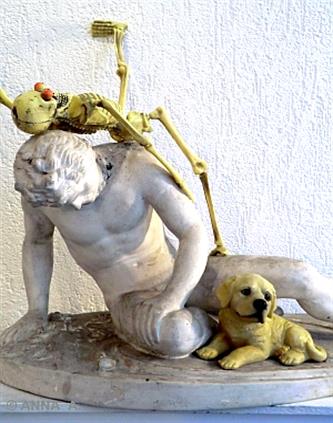
DYING GAUL AND HIS BEST FRIEND,
2012
33 by 48 by 65 cm.
Plaster cast, plastic, resin.
The Dying Gaul, formerly known as the Dying Gladiator, is an ancient Roman marble copy of a lost Hellenistic sculpture, commissioned some time between 230 BC and 220 BC by Attalus I of Pergamon to celebrate his victory over the Celtic Galatians in Anatolia.
The statue depicts a dying Celt with remarkable realism, particularly in the face, and may have been painted. He is represented as a Gallic warrior with a typically Gallic hairstyle and moustache. The figure is nude save for a neck torc. He lies on his fallen shield while his sword and other objects lie beside him as well as - in ANNA AGTMA’s imagination - his loyal dog that seems to be aware of the sad situation.
The Dying Gaul became one of the most celebrated works to have survived from antiquity and was engraved and endlessly copied by artists. It was requisitioned by Napoleon Bonaparte during his invasion of Italy and taken in triumph to Paris.
The artistic quality and expressive pathos of the Gaul aroused great admiration among the educated classes in the 17th and 18th centuries and was a “must-see” sight on the Grand Tour of Europe. Byron was one such visitor, commemorating the statue in his poem Childe Harold’s Pilgrimage”.
2012
33 by 48 by 65 cm.
Plaster cast, plastic, resin.
The Dying Gaul, formerly known as the Dying Gladiator, is an ancient Roman marble copy of a lost Hellenistic sculpture, commissioned some time between 230 BC and 220 BC by Attalus I of Pergamon to celebrate his victory over the Celtic Galatians in Anatolia.
The statue depicts a dying Celt with remarkable realism, particularly in the face, and may have been painted. He is represented as a Gallic warrior with a typically Gallic hairstyle and moustache. The figure is nude save for a neck torc. He lies on his fallen shield while his sword and other objects lie beside him as well as - in ANNA AGTMA’s imagination - his loyal dog that seems to be aware of the sad situation.
The Dying Gaul became one of the most celebrated works to have survived from antiquity and was engraved and endlessly copied by artists. It was requisitioned by Napoleon Bonaparte during his invasion of Italy and taken in triumph to Paris.
The artistic quality and expressive pathos of the Gaul aroused great admiration among the educated classes in the 17th and 18th centuries and was a “must-see” sight on the Grand Tour of Europe. Byron was one such visitor, commemorating the statue in his poem Childe Harold’s Pilgrimage”.
Sold